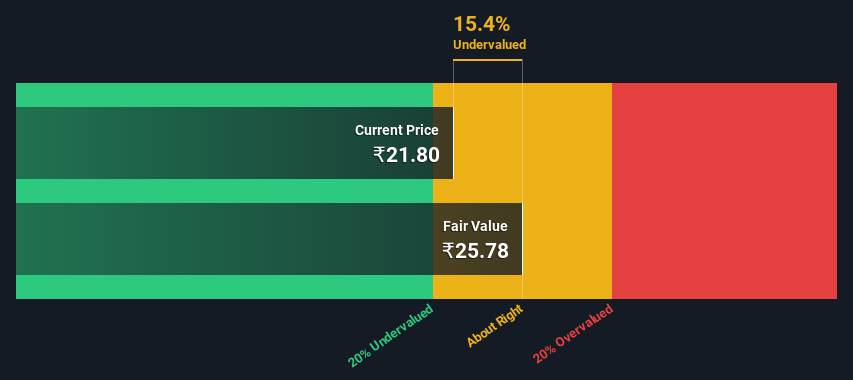
Key Insights
- Nandan Denim's estimated fair value is ₹25.78 based on 2 Stage Free Cash Flow to Equity
- Nandan Denim's ₹21.80 share price indicates it is trading at similar levels as its fair value estimate
- The average premium for Nandan Denim's competitorsis currently 1,853%
Does the April share price for Nandan Denim Limited (NSE:NDL) reflect what it's really worth? Today, we will estimate the stock's intrinsic value by taking the expected future cash flows and discounting them to their present value. This will be done using the Discounted Cash Flow (DCF) model. Believe it or not, it's not too difficult to follow, as you'll see from our example!
Companies can be valued in a lot of ways, so we would point out that a DCF is not perfect for every situation. If you want to learn more about discounted cash flow, the rationale behind this calculation can be read in detail in the Simply Wall St analysis model.
Check out our latest analysis for Nandan Denim
Is Nandan Denim Fairly Valued?
We are going to use a two-stage DCF model, which, as the name states, takes into account two stages of growth. The first stage is generally a higher growth period which levels off heading towards the terminal value, captured in the second 'steady growth' period. To start off with, we need to estimate the next ten years of cash flows. Seeing as no analyst estimates of free cash flow are available to us, we have extrapolate the previous free cash flow (FCF) from the company's last reported value. We assume companies with shrinking free cash flow will slow their rate of shrinkage, and that companies with growing free cash flow will see their growth rate slow, over this period. We do this to reflect that growth tends to slow more in the early years than it does in later years.
Generally we assume that a dollar today is more valuable than a dollar in the future, so we discount the value of these future cash flows to their estimated value in today's dollars:
10-year free cash flow (FCF) estimate
| 2023 | 2024 | 2025 | 2026 | 2027 | 2028 | 2029 | 2030 | 2031 | 2032 | |
| Levered FCF (₹, Millions) | ₹654.1m | ₹722.6m | ₹790.3m | ₹858.3m | ₹927.5m | ₹998.8m | ₹1.07b | ₹1.15b | ₹1.23b | ₹1.32b |
| Growth Rate Estimate Source | Est @ 12.03% | Est @ 10.47% | Est @ 9.37% | Est @ 8.60% | Est @ 8.06% | Est @ 7.69% | Est @ 7.42% | Est @ 7.24% | Est @ 7.11% | Est @ 7.02% |
| Present Value (₹, Millions) Discounted @ 26% | ₹520 | ₹457 | ₹397 | ₹343 | ₹295 | ₹252 | ₹215 | ₹184 | ₹156 | ₹133 |
("Est" = FCF growth rate estimated by Simply Wall St)
Present Value of 10-year Cash Flow (PVCF) = ₹3.0b
The second stage is also known as Terminal Value, this is the business's cash flow after the first stage. The Gordon Growth formula is used to calculate Terminal Value at a future annual growth rate equal to the 5-year average of the 10-year government bond yield of 6.8%. We discount the terminal cash flows to today's value at a cost of equity of 26%.
Terminal Value (TV)= FCF2032 × (1 + g) ÷ (r – g) = ₹1.3b× (1 + 6.8%) ÷ (26%– 6.8%) = ₹7.4b
Present Value of Terminal Value (PVTV)= TV / (1 + r)10= ₹7.4b÷ ( 1 + 26%)10= ₹749m
The total value, or equity value, is then the sum of the present value of the future cash flows, which in this case is ₹3.7b. To get the intrinsic value per share, we divide this by the total number of shares outstanding. Relative to the current share price of ₹21.8, the company appears about fair value at a 15% discount to where the stock price trades currently. The assumptions in any calculation have a big impact on the valuation, so it is better to view this as a rough estimate, not precise down to the last cent.

Important Assumptions
Now the most important inputs to a discounted cash flow are the discount rate, and of course, the actual cash flows. Part of investing is coming up with your own evaluation of a company's future performance, so try the calculation yourself and check your own assumptions. The DCF also does not consider the possible cyclicality of an industry, or a company's future capital requirements, so it does not give a full picture of a company's potential performance. Given that we are looking at Nandan Denim as potential shareholders, the cost of equity is used as the discount rate, rather than the cost of capital (or weighted average cost of capital, WACC) which accounts for debt. In this calculation we've used 26%, which is based on a levered beta of 1.950. Beta is a measure of a stock's volatility, compared to the market as a whole. We get our beta from the industry average beta of globally comparable companies, with an imposed limit between 0.8 and 2.0, which is a reasonable range for a stable business.
SWOT Analysis for Nandan Denim
- No major strengths identified for NDL.
- Earnings declined over the past year.
- Interest payments on debt are not well covered.
- Current share price is below our estimate of fair value.
- Lack of analyst coverage makes it difficult to determine NDL's earnings prospects.
- Debt is not well covered by operating cash flow.
Moving On:
Although the valuation of a company is important, it is only one of many factors that you need to assess for a company. DCF models are not the be-all and end-all of investment valuation. Rather it should be seen as a guide to "what assumptions need to be true for this stock to be under/overvalued?" For instance, if the terminal value growth rate is adjusted slightly, it can dramatically alter the overall result. For Nandan Denim, we've compiled three pertinent items you should look at:
- Risks: For instance, we've identified 4 warning signs for Nandan Denim (2 shouldn't be ignored) you should be aware of.
- Other High Quality Alternatives: Do you like a good all-rounder? Explore our interactive list of high quality stocks to get an idea of what else is out there you may be missing!
- Other Top Analyst Picks: Interested to see what the analysts are thinking? Take a look at our interactive list of analysts' top stock picks to find out what they feel might have an attractive future outlook!
PS. Simply Wall St updates its DCF calculation for every Indian stock every day, so if you want to find the intrinsic value of any other stock just search here.
Valuation is complex, but we're here to simplify it.
Discover if Nandan Denim might be undervalued or overvalued with our detailed analysis, featuring fair value estimates, potential risks, dividends, insider trades, and its financial condition.
Access Free AnalysisHave feedback on this article? Concerned about the content? Get in touch with us directly. Alternatively, email editorial-team (at) simplywallst.com.
This article by Simply Wall St is general in nature. We provide commentary based on historical data and analyst forecasts only using an unbiased methodology and our articles are not intended to be financial advice. It does not constitute a recommendation to buy or sell any stock, and does not take account of your objectives, or your financial situation. We aim to bring you long-term focused analysis driven by fundamental data. Note that our analysis may not factor in the latest price-sensitive company announcements or qualitative material. Simply Wall St has no position in any stocks mentioned.
About NSEI:NDL
Nandan Denim
Engages in the manufacture and sale of denim and cotton fabrics, dyed yarns, shirting fabrics, and fibers in India.
Adequate balance sheet low.
Market Insights
Community Narratives


